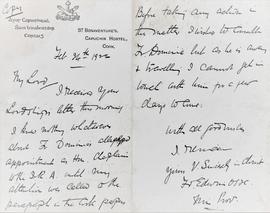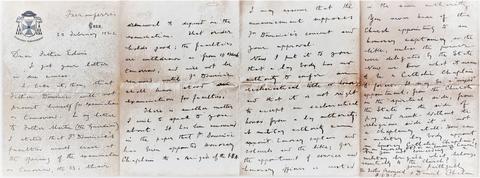Identity area
Reference code
Title
Date(s)
- 22 Feb. 1922-24 Feb. 1922 (Creation)
Level of description
Extent and medium
6 pp; Manuscript
Context area
Name of creator
Biographical history
John Francis O’Connor was born on 13 Feb. 1883 in County Cork. He was born into a devoutly Catholic family. His father, John O’Connor, a teacher, and his mother, Mary Ann Sheehan, were both tertiaries of the Third Order of St. Francis attached to Holy Trinity Capuchin Church, Cork. A brother of Many Ann Sheehan had already joined the Capuchin Franciscan Order. Fr. Luke Sheehan OFM Cap. was one of the first Catholic missionaries to minister in the American state of Oregon. A good number of John’s siblings also entered religious life. John entered Rochestown College, Cork, in the Autumn of 1897. Having successfully completed his secondary education, he entered the Capuchin novitiate on 1 Oct. 1899 and received the religious name of Dominic. A year later he took his simple vows and in the Autumn of the same year began studying for a philosophy degree in the Royal University, Cork. He was ordained a priest on 17 Mar. 1906 in the Capuchin Friary in Kilkenny. He later enrolled in the Catholic University in Louvain where he obtained a Sacrae Theologiae Baccalaureus (Bachelor of Sacred Theology). In response to a call from Cardinal Michael Logue, Archbishop of Armagh, Fr. Dominic volunteered for chaplaincy work with the British armed forces during the First World War. After spending two months with a Scottish brigade in England, he transferred to a hospital unit bound for Salonika, Greece. After approximately two years of service, Fr. Dominic resigned his post in 1917, returned to Ireland and was appointed to the Capuchin community in Holy Trinity Friary, Cork. Fr. Dominic soon attained notoriety in nationalist circles and was appointed chaplain to the Cork Brigade of IRA Volunteers by Tomas MacCurtain. As chaplain, Fr. Dominic was the first to appear at the MacCurtain home in Blackpool, Cork, on the morning the Sinn Féin Lord Mayor was killed by British forces (20 Mar. 1920). He also served as chaplain to MacCurtain’s successor as Lord Mayor of Cork, Terence MacSwiney, who was arrested on 12 Aug. 1920. Fr. Dominic ministered to MacSwiney throughout his hunger strike in Brixton Prison and was present for his death on 25 Oct. 1920. Soon after his return to Ireland, Fr. Dominic was arrested at the Capuchin Friary on Church Street, Dublin. He was taken to Dublin Castle and in January 1921 was court martialled and sentenced to five years’ imprisonment. During his confinement, he became acquainted with two notable republican detainees, Ernie O’Malley and Pádraig Ó Caoimh. Fr. Dominic served about a year of his imprisonment in Parkhurst Prison. Following the Anglo-Irish Treaty in December 1921, there was a general amnesty for prisoners and Fr. Dominic was released in January 1922. On 25 February 1922, he was granted the freedom of Cork ‘as a mark of respect for his valuable services rendered to the first two Republican Lord Mayors of Cork’. With the onset of the Civil War the Capuchins in Church Street were once more involved in ministering to besieged republicans. In June 1922 the Four Courts, located only a couple of hundred meters from the Church Street Friary, was attacked by Free State forces. Fr. Dominic (assisted by Fr. Albert Bibby OFM Cap.) provided spiritual comfort, assisted in the evacuation of the wounded, and later facilitated the surrender of the defeated garrison. Soon afterwards, Fr. Dominic returned to Holy Trinity Friary, Cork. On 26 Nov. 1922 a decision was made by the Provincial Definitory of the Irish Capuchins to have Fr. Dominic transferred to the Province’s Mission in Bend, Oregon, United States. This was the location of Fr. Luke Sheehan’s (Fr. Dominic’s uncle) pioneering missionary work some years before. For the remainder of his life Fr. Dominic performed routine duties associated with the missionary apostolate of a Capuchin friar. He was appointed temporary rector of St. Francis de Sales Cathedral and published the first of a two-volume history of the Diocese of Baker in 1930. In August 1935 he sustained serious injuries in a car accident from which he never fully recovered. He died on 17 Oct. 1935 and was buried in Bend, Oregon. His remains (along with those of Fr. Albert Bibby OFM Cap.) were later repatriated to Ireland and he was buried in the cemetery of Rochestown Capuchin Friary, Cork, on 14 June 1958
Name of creator
Biographical history
He was born in Kilmichael in County Cork, Ireland on 14 July 1858. After graduating at St Patrick's College, Maynooth, Cohalan was ordained a priest at the Cathedral of St Mary and St Anne, Cork on 25 July 1882. His first pastoral appointment was a curate at Kilbrittain, County Cork from October 1883 to January 1884. He briefly resumed his post-graduate studies at St Finbarr's Seminary (now College), Cork from January to November 1884. His second curacy was at Tracton, County Cork from November 1884 to September 1896. Cohalan returned to St. Patrick's College, Maynooth as a professor of Theology from 7 September 1896 to 7 June 1914.
He was appointed Auxiliary Bishop of Cork and Titular Bishop of Vaga on 25 May 1914. Cohalan was consecrated bishop at St Mary and St Anne's Cathedral on 7 June 1914 by John Harty, Archbishop of Cashel-Emly. Two years later, he was appointed Diocesan Bishop of Cork on 29 August 1916.
Cohalan was an outspoken critic during the Irish War of Independence, condemning acts of violence on both sides. In particular, he denounced the policy of reprisals. In July 1920, he pronounced an interdict on the killers of an RIC sergeant, shot dead in the church porch in Bandon. He declared that anyone killing from ambush would be excommunicated. On 12 December 1920, Cohalan, issued a decree saying that "anyone within the diocese of Cork who organises or takes part in ambushes or murder or attempted murder shall be excommunicated". In turn, his life was threatened by the IRA. In August 1928, he condemned the British government which had allowed Terence McSwiney to die on hunger-strike in 1920.
He died in office at Bon Secours Hospital, Cork on 24 August 1952, aged 94 years old.
Originally buried at St Finbarr's College, Farranferris, he was reinterred in the grounds of St Mary and St Anne's Cathedral, Cork in 1996.
His nephew of the same name, Daniel Cohalan, was Bishop of Waterford and Lismore from 1943 to 1965.
Repository
Archival history
Immediate source of acquisition or transfer
Content and structure area
Scope and content
Letter from the Most Rev. Daniel Cohalan, Bishop of Cork, to Fr. Edwin Fitzgibbon OFM Cap., Provincial Minister, referring to the withdrawal of Fr. Dominic’s faculties due to his inability to take the examination for renewal of faculties. Bishop Cohalan also refers to his unease on reading an announcement in the papers that Fr. Dominic is to be appointed honorary chaplain to a brigade of the IRA. The Bishop wrote: ‘Now I put it to you that a lay body has no authority to confer an ecclesiastical honour from a lay authority’. He later asks Fr. Edwin: ‘Are you not conceding to a military brigade what belongs essentially to the church?’ With a copy reply from Fr. Edwin claiming that he knew nothing of Fr. Dominic's appointment as chaplain to the IRA until his attention was drawn to a report in the Cork newspapers.


